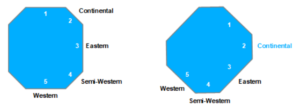Learn tennis smash
In 5 steps to the perfect tennis smash as a beginner
In 5 steps to the perfect tennis smash as a beginner
The smash is a tennis stroke played over the head, which often successfully ends the rally because of the high speed. For fear of making a mistake, many tennis beginners bounce the ball normally and play a forehand or backhand.
This does not have to be the case, because it is comparatively easy to win the point with the smash. In doubles, it is also advantageous to play a good smash, because there are significantly more smashes to hit due to the positioning of the players.
Therefore, you should also practice the smash diligently. Below we explain to tennis beginners the 5 steps to the perfect tennis butterball: from the butterball grip, the backswing, the motion sequence and the outswing to butterball tips.
1. Tennis smash grip
In tennis, the smash is the response to a high opponent’s ball, which is usually played in front near the net. There are two basic variations of the smash: you smash the tennis ball directly out of the air or you bounce the tennis ball and then smash it.
For both variations of the butterball, you can use the so-called Continental grip, just like with the serve. The Continental grip offers you the chance to give the tennis ball a different spin depending on the position of the opponent and thus to win the point if possible.

2. Tennis smash backswing
You are usually in front near the net and see a high ball from your opponent coming towards you. You turn sideways to the net. If you are right-handed, your left foot is in front. If you are left-handed, your right foot is in front.
Your upper body is also turned sideways to the net and you stand wide-legged and comfortable. This starting position gives you a stable stance for the butterfly.
You try to anticipate where the tennis ball will land and continue to move to this position turned sideways accordingly. If the tennis ball is very high and will land almost vertically, it is advisable to bounce it and then hit it.
For both variations, point your outstretched non-hitting hand upward – either directly or after bouncing – at the tennis ball. At the same time, the arm with the tennis racket bends – as with the serve – so that the tennis racket is put into an imaginary backpack. In addition, you bend your knees on both sides – a little lower on the back foot.
3. Tennis smash movement
For the perfect movement of the butterfly, you then accelerate the hitting arm upwards over your head and you hit the ball in full extension at the highest point in front of your body. The hand directed at the ball is at that moment already on the way down again.
You shift your weight from the back foot to the front by fully extending your knees to generate even more power. Shortly before the point of impact of the tennis ball, additionally snap your hitting arm wrist downward so that a little extra power is mobilized here as well.
4. Tennis smash outswing
For the outswing of the smash, continue the natural motion: swing the tennis racket down past the other side of your body and take the 2nd hand back to the racket handle and move to the center of the court or starting position.
Again, note that the backswing, motion sequence and outswing is a fluid motion.
5. Typical tennis smash mistakes and tips
a) Look at the tennis ball when hitting it
The most common mistake made by tennis beginners is that they turn their eyes away from the incoming ball too early, automatically making them smaller. The smash ball should be hit in full extension and the tennis ball should be watched closely. Looking away too early often leads to incorrect hitting points and thus loss of points.
b) Perform the motion sequence early on
Many tennis beginners quickly recognize the parallels to the serve. However, there is a huge difference: the ball is not lifted gently as in the serve, but the ball comes straight at you from the opponent at a higher speed. Therefore, accelerate the tennis racket early so that the tennis ball does not fly past you. With a little practice, this should no longer be a problem for you.
c) Jump while running sideways backwards
A good lob from your opponent gives you a chance to play a particularly difficult smash. However, many beginners give up the chance to reach the tennis ball early.
With a little practice, this doesn’t have to be the case: if you see that the ball is going to be difficult to reach, lengthen your stretch by jumping backwards – still in the lateral position – and at the same time moving the butterball fluidly as described. You’ll be surprised how many butterflies you can still play successfully.

